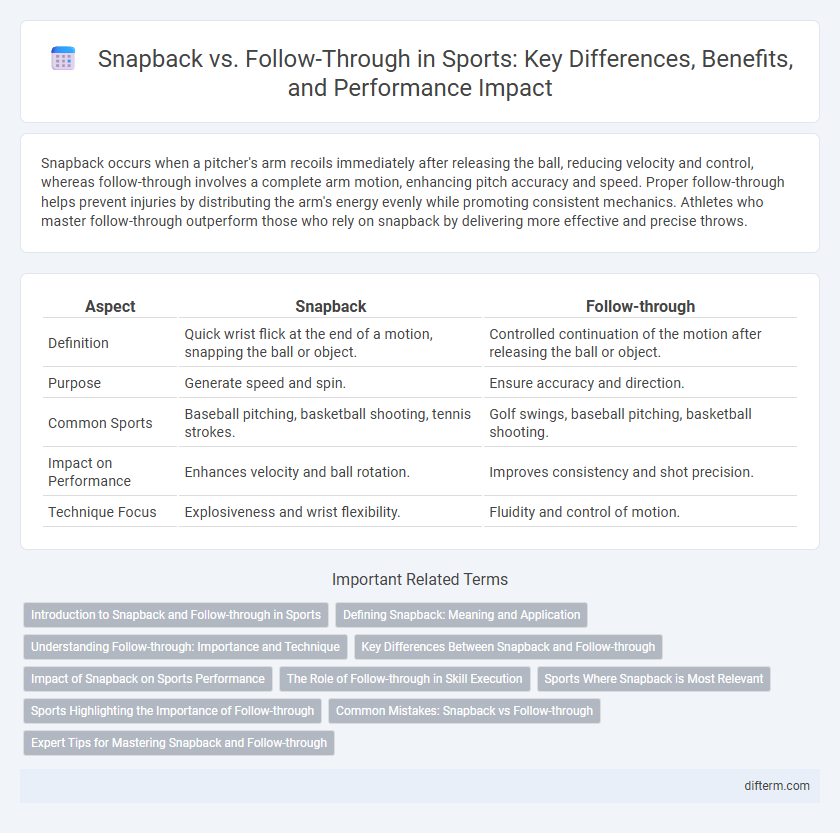Snapback occurs when a pitcher's arm recoils immediately after releasing the ball, reducing velocity and control, whereas follow-through involves a complete arm motion, enhancing pitch accuracy and speed. Proper follow-through helps prevent injuries by distributing the arm's energy evenly while promoting consistent mechanics. Athletes who master follow-through outperform those who rely on snapback by delivering more effective and precise throws.
Table of Comparison
| Aspect | Snapback | Follow-through |
|---|---|---|
| Definition | Quick wrist flick at the end of a motion, snapping the ball or object. | Controlled continuation of the motion after releasing the ball or object. |
| Purpose | Generate speed and spin. | Ensure accuracy and direction. |
| Common Sports | Baseball pitching, basketball shooting, tennis strokes. | Golf swings, baseball pitching, basketball shooting. |
| Impact on Performance | Enhances velocity and ball rotation. | Improves consistency and shot precision. |
| Technique Focus | Explosiveness and wrist flexibility. | Fluidity and control of motion. |
Introduction to Snapback and Follow-through in Sports
Snapback and follow-through are critical phases in athletic movements that influence performance and injury prevention. Snapback refers to the rapid return of a limb or body part to its original position after exertion, commonly seen in sports like baseball pitching or tennis serving. Follow-through involves the controlled continuation of movement after the primary action, ensuring accuracy and reducing strain in activities such as golf swings and basketball shots.
Defining Snapback: Meaning and Application
Snapback in sports refers to the rapid return of a body part, such as a wrist or ankle, to its original position following a dynamic movement, contributing to enhanced control and precision. This technique is pivotal in sports like baseball, basketball, and tennis, where quick, controlled rebounds optimize performance and reduce injury risks. Understanding snapback mechanics allows athletes to refine their timing and improve overall efficiency during high-speed plays.
Understanding Follow-through: Importance and Technique
Mastering the follow-through in sports like basketball or baseball enhances accuracy and power by ensuring proper extension and balance after the initial action. A well-executed follow-through improves muscle memory, promotes consistency, and reduces the risk of injury by maintaining controlled movement. Coaches emphasize follow-through technique to optimize performance and develop sustained athletic skill across various sports disciplines.
Key Differences Between Snapback and Follow-through
Snapback in sports refers to the rapid recoil motion of a limb or equipment immediately after impact, emphasizing speed and control, while follow-through involves the continuation of movement beyond the point of contact, critical for accuracy and power. Key differences lie in snapback's role in generating quick energy release and follow-through's function in maintaining momentum and direction. Understanding these distinctions is essential for athletes in sports like tennis, baseball, and golf to optimize technique and performance outcomes.
Impact of Snapback on Sports Performance
Snapback velocity significantly enhances an athlete's power output by maximizing elastic energy stored in muscles during rapid deceleration. This biomechanical efficiency improves acceleration and explosive strength crucial in sports like baseball pitching and tennis serves. Proper snapback technique reduces injury risk while optimizing force transfer, directly boosting overall sports performance metrics.
The Role of Follow-through in Skill Execution
Follow-through plays a crucial role in skill execution by ensuring accuracy and power in sports movements such as batting, throwing, and kicking. A controlled follow-through maintains momentum and directs energy towards the target, enhancing precision and consistency. Neglecting follow-through can lead to decreased performance and increased risk of injury due to improper mechanics.
Sports Where Snapback is Most Relevant
Snapback technique is most relevant in sports like baseball, tennis, and golf, where controlling the speed and direction of the bat, racket, or club during the follow-through impacts performance. Snapback enhances power generation and precision by quickly reversing the movement after the point of contact, enabling athletes to maintain control and optimize their swing mechanics. In contrast, follow-through is more focused on sustaining momentum and balance but is less critical for maximizing explosive force in these specific sports.
Sports Highlighting the Importance of Follow-through
Snapback and follow-through are critical techniques in various sports, but follow-through significantly impacts performance by ensuring accuracy and power in every action. In basketball shooting, for instance, a proper follow-through maintains the ball's trajectory while in baseball pitching, it prevents injury by controlling arm movement. Studies show athletes who emphasize follow-through improve consistency and reduce muscle strain, highlighting its key role in optimizing athletic outcomes.
Common Mistakes: Snapback vs Follow-through
Common mistakes in sports often involve confusing snapback with follow-through techniques, where athletes either abruptly snap back their limbs too early or fail to maintain proper motion after impact. Snapback errors typically result in loss of power and accuracy, whereas poor follow-through can cause decreased control and increased risk of injury. Mastering the distinction between snapback and follow-through is crucial for optimizing performance in sports such as baseball pitching, golf swings, and tennis strokes.
Expert Tips for Mastering Snapback and Follow-through
Mastering snapback and follow-through depends on precise timing and controlled motion for peak athletic performance. Experts emphasize focused wrist action during snapback to enhance power and acceleration, while a full follow-through ensures accuracy and injury prevention. Consistent practice of these techniques improves muscle memory and optimizes biomechanics in sports like baseball, tennis, and golf.
Snapback vs Follow-through Infographic

 difterm.com
difterm.com